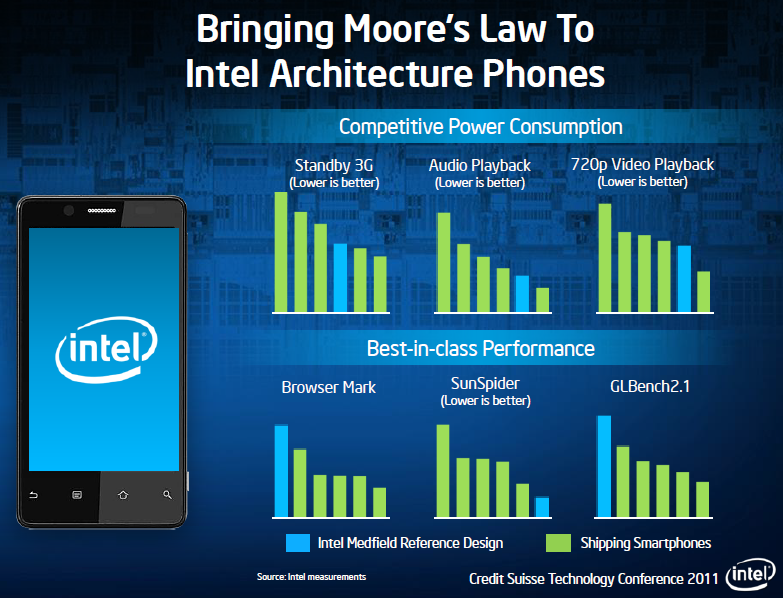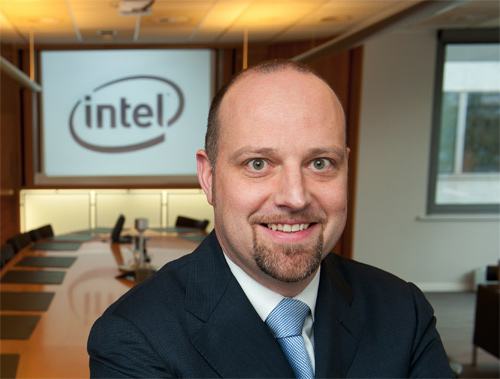In the next part of our interview with Pat Bliemer we discuss smartphones, and how the market is changing. We find out that it has units from two relevant partners to announce, but also that Intel will be less dependent of the PC market.
Intel has been shifting focus over the last few years: to get into the growing ultramobile market. Smartphones and also tablets are growing and becoming more relevant with each day. The uses for these type of devices continues to grow and the face of the traditional PC market is changing. But to do that you need highly efficient circuits and to Intel that is synonymous to PC it has been a real challenge. Intel’s Pat Bliemer believes that through its world-leading manufacturing technology and expertise it has the right ingredients to get into the ARM-dominated market. Besides two relavant partners ready to launch its first smartphones he believes it will be even more competitive with its 22nm technology.
“I always think you have to go wait, it’s the market that will decide – not us. But I am very confident based on what I’ve seen in terms of plans and design wins that we have – which I cannot share in detail. But we have two relevant parties to announces when they launch. We will definitely have much better and competitive products with the next node, absolutely.”
The Medfield platform for smartphones and tablets that is currently available runs at 32nm, and Intel has two partners ready to announce products in the first half of 2012. When we asked when we will see the first Intel-powered smartphones on the Nordoc market he could not say for certain. Although we were happy with his responce, that the Nordic market has always been lucrative for new technology.
Smartphones with Intel’s circuits in six months
“So it will definitely be 2012. For Nordic markets specific I wouldn’t be able to go tell you if that would be Q2 or Q3 or something like that. The current plans are that in the first half of 2012 the first Intel-based smartphones will become available in the market place. I do think however, the Nordics has always been really fast in tech adoption and is a mobility minded region of course. So I would imagine that the products here would become available quite fast after they get injected into the market.”
We asked the unavoidable question what Intel thought of Windows 8 and ARM, and the fact that we have been stuck with the alternative x86 and Windows. He could only agree with s, but also added that Intel will be less dependent on the PC market in the future. Intel is spending a lot of energy on scaling down its products with lower energy consumption and sufficient performance, for smartphones and alternative mobile units like tablets.
“Of course that’s been the platform of choice [Windows and x86] and a default more or less platform for the last decade or so. But I think what you see now is that Intel – we are growing in terms of our future business and dependency less on PC and more to smartphones and alternative mobile devices like tablets. We are going to come from high performance and relatively higher power, we are going to have to scale down to good performance and very low power – and that’s effectively where ARM sits with their architecture, and they are coming up so we’re kind of meeting and in the middle right now and that’s where we see each other.”
Last but not least we told him of a discussion we had with AMD about where the market was heading. Pat Bliemer doesn’t believe that the end users will care as much what is inside the units, but only the experience they have to offer. Intel’s challenge will be to show end users and consumers that there is something unique that is powering the device. Intel also has a strong roadmap that he believes will help Intel to compete with the ARM architecture.
 Intel’s challenge will be to enlighten users that there is something special with its products
Intel’s challenge will be to enlighten users that there is something special with its products
“I just think that at the end of the day, people are not going to care as much as an end-user, experience and how they would rate performance or the experience of a divide they use based on what is underneath. We need to make very clear that they do understand that part of that experience is delivered by something unique underneath and that’s basically what Intel will continue to drive. So obviously we are going to continue go down that path, and we believe we have a very competitive roadmap to compete effectively against that architecture.”
We will publish more from the hour-long interview with Pat Bliemer in the coming days, so keep an eye out for more fresh material. We go into the competition with AMD and the weight of having good integrated graphics inside the processor.















